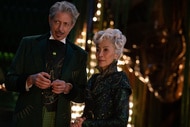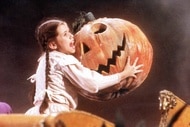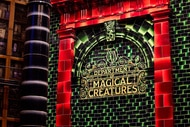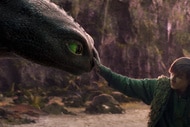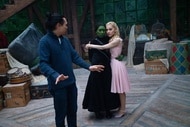Create a free profile to get unlimited access to exclusive videos, sweepstakes, and more!
How pre-WWII Expressionism inspired the look of 'Cirque du Freak: The Vampire's Assistant'
"There's a real sense of the macabre about it."

Before Adolf Hitler and the Nazis seized control of Germany in the 1930s and plunged the world into chaos, Berlin was a renowned epicenter of artistic freedom. Expressionist painters like Max Beckmann, Otto Dix, and Ludwig Kirchner exaggeratedly splashed the horrors of the First World War onto canvas, unaware that they were merely living in a lull between two bloody conflicts that would shape the 20th century. "I've liked German Expressionist painting for a long time. It’s often very colorful and then also very grim, because it's coming out of World War I. So there's a real sense of the macabre about it," explains filmmaker Paul Weitz (American Pie, About a Boy).
Paul's father (a German Jew) escaped Europe and joined the U.S. military as an intelligence officer prior to the outbreak of World War II and the Holocaust, but not before witnessing this brief age of cultural democracy (one stamped out by the jackboot of fascism) and its "vibrant world of people who were not going by conventional social morays," explains Paul, who ultimately channeled the aesthetic of pre-WWII Germany for his sixth directorial outing — 2009's Cirque du Freak: The Vampire's Assistant.
"I think that made me love the idea of this circus of freaks, who were living outside of outside of the norm, but who had this sort of family," he adds. "And then [I wanted to] combine that with a coming-of-age story and what it means to become your own person."
Based on the first three books in Darren O'Shaughnessy's The Saga of Darren Shan YA series, the film stars Chris Massoglia as Darren Shan, an average teenager taken under the wing of Larten Crepsley (John C. Reilly), a non-violent bloodsucker and cast member of Cirque du Freak, a traveling show made up of social pariahs gifted with unique abilities. Resentful of his best friend's newfound acceptance amongst the vampire community, Darren's wayward pal, Steve Leonard (Josh Hutcherson), throws in his lot with a murderous sect of the undead called the Vampaneze.
"I was interested in themes of normalcy versus individualism. That's what the whole movie was about: conformity and somebody coming from this really bland world where there's a certain expectation," Weitz says. "Everybody at the school where the two kids go — except for Steve — is dressed in pastels, basically. And when [Darren] meets the people from this Cirque, they're all in bright, rich, colors. I was also really interested in the idea that Steve really would like to fit into a non-evil world of vampires, but he gets rejected and in that rejection, he becomes evil ... This idea that like people who are ‘bad’ — like Steve — might not be the choice that they would make if they if they really had a choice. Certain people are kind of screwed in the hand that they're dealt."
While Massoglia and Hutcherson were up-and-comers at the time, the collection of supporting players was a veritable who's who of acting talent: John C. Reilly, Salma Hayek, Willem Dafoe, Orlando Jones, Jane Krakowski, Ken Watanabe, Ray Stevenson, Kristen Schaal, and Frankie Faison. Reilly, in particular, served as the ringer leader, committing himself 100 percent to the role of Larten.
"He really wanted to make sure that he wasn't just goofing; that the seriousness of that character came through. I remember him coming to the trailer and he'd be reading through the books over and over and over again — reading dialogue from the books aloud and trying to get a rhythm in his head. It was cool," says Weitz, who shared script credit with Brian Helgeland.
He continues: "I remember John was so in character, that when he was having his big battle scene with Ray Stevenson [who plays the Vampeneze called Murlough] in the theater, we were up on the third balcony, meaning [there was] a very large drop beyond this balcony into the main house below. He got up on the f***ing railing of this balcony and was doing a tightrope walk along it. On one side, he’d okay if he fell, and on the other side, he would have absolutely broken his neck. He just did it and it terrified me. But I think he was in character as this vampire who could withstand a terrible fall. John has a lot of skills that are almost like circus skills. He’s kind of an old-time showman on top of being a really excellent actor. So it was fun having him playing that part of his character."
The bulk of production took place in New Orleans, just three years after the horrific destruction wrought by Hurricane Katrina. "The theater that we shot in a lot there, you can see a line along the seats where the water had risen to. I think there was a wicked amount of mold," recalls Weitz, who contracted bacterial pneumonia during principal photography.
"There was one day I was really dragging," he continues. "We shot on film back then and I used to do push-ups in between every magazine change, and I couldn't do it. I was like, ‘What's going on here?’ It turned out I caught pneumonia, possibly from one of those locations, where it was completely moldy. I think being in New Orleans was a big thing for people, getting to spend time down there, particularly as it was kind of rebuilding itself."
Cirque du Freak: The Vampire's Assistant opened in theaters right before Halloween in October 2009. Unfortunately, the film was a critical and box office misfire, garnering $39 million worldwide against a budget of $40 million, which immediately put an end to plans for an entire YA film franchise. The filmmakers wouldn't have been wanting for material, given the fact that The Saga of Darren Shan spans 12 books. "I was really bummed out that I didn't put us in a position to have it be series," Weitz admits.
"I wish someone else would make a totally different series," he adds. "They did it with The Golden Compass ... There is a different, and no doubt, extremely cool version of this movie that could have been made, which was much darker. But at the time, that was not what people were going for. I'd be interested to see that if someone was to make that."
Had the filmmaker been lucky enough to continue the story onscreen, he would have delved deeper into "the central relationship between Steve and Darren," as well as the idea of fate vs. free will. "Both of those characters are kind of being subjected to fate, but they're reacting differently to what they've been presented with," Weitz explains. "I also think it would have been super cool to get more into Crepsley and Willem’s characters; to get more into the mythology and the upcoming war that's happening [among the vampires]."
As it stands, however, Cirque du Freak remains a delectable and family-friendly treat for the spookiest day on the calendar.
"In order to prepare for the interview, I rewatched it last night with my 11-year-old son and it was cool to see him reacting to it and to realize that it is a movie that you can see when you're pretty young," Weitz concludes. "When it came out, I think it opened opposite one of the Saw movies. It's most certainly not that. It’s not a slasher thing, it’s a more innocent movie that's suitable for Halloween."
Cirque du Freak: The Vampire's Assistant is now streaming on Peacock.
